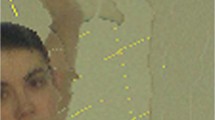Abstract
In 3D video applications, view synthesis is widely used for generating a virtual viewpoint images. However, the quality of synthesized image is dissimilar to captured color image. Furthermore, noise occurs at object boundary areas in synthesized images. In this paper, we propose a new hole filling method to improve the synthesized image quality. In order to synthesize an image without the noise, we remove the boundary noise by expanding it as a hole region. Based on the expanded hole region, we use proposed hole scanning and directional hole filling method in simultaneous time. Additionally, we compute a cost value among the candidate pixels to find out proper hole filling pixel. We conducted experiments on various test sequences for evaluation of the proposed method. The proposed method produces better objective results than other conventional hole filling methods.

















Similar content being viewed by others
References
Redert, A., Op de Beeck, M., Fehn, C., IJsselsteijn, W., Pollefeys, M., Gool, L., Ofek, E., Sexton, I., & Surman, P. (2002). ATTEST: advanced three-dimensional television system technologies. 3D data processing visualization and transmission. doi: 10.1109/TDPVT.2002.1024077.
Fehn, C., Kauff, P., Op de Beeck, M., Ernst, F., IJsselsteijn, W., Pollefeys, M., Van Gool, L., Ofek, E., & Sexton, I. (2002). An evolutionary and optimised approach on 3D-TV. International Broadcast Conference, pp. 357–365.
Tanimoto, M. (2006). FTV (Free Viewpoint Television) for 3D scene reproduction and creation. Proc. of IEEE Computer Vision and Pattern Recognition Workshop (CVPRW), p. 172.
Wilburn, B., Joshi, N., Vaish, V., Talvala, V., Antunez, E., Barth, A., Adams, A., Horowitz, M., & Levoy, M. (2005). High performace imaging using large camera arrays. ACM Transactions on Graphics, 24(3), 765–776.
Cheng, H., An, P., Li, H., & Zhang, Z. (2011). Stereo image rectification algorithm for multi-view 3D display. International conference on 3D Imaging (IC3D), pp. 1–5.
Plath, N., Knorr, S., Goldmann, L., & Sikora, T. (2013). Adaptive image warping for hole prevention in 3D view synthesis. IEEE Transactions on Image Processing, 22(9), 3420–3432.
Macchiavello, B., Dorea, C., Hung, E.M., & Cheung, G. (2013). Saliency-cognizant robust view synthesis in free viewpoint video streaming. IEEE International Conference on Image Processing (ICIP), pp. 1603–1607.
Wiegand, T., Sullivan, G. J., Bjontegaard, G., & Luthra, A. (2003). Overview of the H.264/AVC video coding standard. IEEE Transactions on Circuits and Systems for Video Technology, 13(7), 560–576.
MPEG. (2009). Introduction to 3D video. ISO/IEC JTC1/SC29/WG11 document N 10357.
Yuan, H., Calic, J., & Kondoz, A. (2014). Facilitating interaction with stereoscopic 3D display devices. 3DTV-Conference: The True Vision –Capture, Transmission and display of 3D Video (3DTV-CON), pp. 1–4.
Vazquez, C., Tam. W. J., & Spernaza, F. (2006). Stereoscopic imaging: filling disoccluded areas in depth image-based rendering. Proc. SPIE, vol. 6392. doi: 10.1117/12.685047.
Lee. C., & Ho, Y.S. (2009). View synthesis using depth map for 3D video. Asia-Pacific Signal and International Processing Association (APSIPA), pp. 1–8.
Acknowledgments
This research was supported by the‘Cross-Ministry Giga KOREA Project’ of the Ministry of Science, ICT and Future Planning, Republic of Korea (ROK). [GK15C0100, Development of Interactive and Realistic Massive Giga-Content Technology]
Author information
Authors and Affiliations
Corresponding author
Rights and permissions
About this article
Cite this article
Mun, JH., Ho, YS. Multi-directional Hole Filling Method for Virtual View Synthesis. J Sign Process Syst 85, 211–219 (2016). https://doi.org/10.1007/s11265-015-1069-2
Received:
Revised:
Accepted:
Published:
Issue Date:
DOI: https://doi.org/10.1007/s11265-015-1069-2




